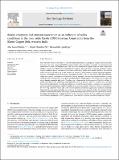Files in this item
Biotite chemistry and mineral association as an indicator of redox conditions in the iron oxide Cu-Au (IOCG) system : constraints from the Khetri Copper Belt, western India
Item metadata
| dc.contributor.author | Baidya, Abu Saeed | |
| dc.contributor.author | Pal, Dipak Chandra | |
| dc.contributor.author | Upadhyay, Dewashish | |
| dc.date.accessioned | 2022-01-11T15:30:06Z | |
| dc.date.available | 2022-01-11T15:30:06Z | |
| dc.date.issued | 2021-12 | |
| dc.identifier | 277164113 | |
| dc.identifier | 9d0f54b2-8ff3-498e-ab4b-f2f351344f8c | |
| dc.identifier | 85118531236 | |
| dc.identifier.citation | Baidya , A S , Pal , D C & Upadhyay , D 2021 , ' Biotite chemistry and mineral association as an indicator of redox conditions in the iron oxide Cu-Au (IOCG) system : constraints from the Khetri Copper Belt, western India ' , Ore Geology Reviews , vol. 139 , no. Part B , 104544 . https://doi.org/10.1016/j.oregeorev.2021.104544 | en |
| dc.identifier.issn | 0169-1368 | |
| dc.identifier.uri | https://hdl.handle.net/10023/24644 | |
| dc.description | Authors acknowledge the officials and geologists of Hindusthan Copper Limited for their help during the fieldwork. The analytical expenditure was supported by the financial grant to DCP through “Promotion of University Research and Scientific Excellence (PURSE)”-phase-II programme of Jadavpur University (No. DST/SR/PURSE Phase II/6 dated 23.09.2015) by the Department of Science and Technology, Government of India and to ASB through the Shyama Prasad Mukherjee Fellowship (Reference No. SPM-09/096(0184)/2013-EMR-I) from the Council for Scientific and Industrial Research, Government of India. Robert Dymek and Eileena Das helped us in calculating Fe3+ in biotite. Rupashree Saha is acknowledged for her help during the microscopic study, analysis, and initial Fe3+ calculations. | en |
| dc.description.abstract | Key constraints related to the nature of alteration and mineralization in geologically complex and economically important iron oxide copper–gold (IOCG) systems remain highly speculative, especially, the physicochemical characteristics of the hydrothermal fluids. This study was conducted on samples from the Khetri Copper Belt (KCB) in western India that hosts several IOCG-type deposits. The study aims to constrain qualitative oxygen fugacity conditions during alteration-mineralization events using biotite and uraninite chemistry. The inferred redox conditions are backed up by the presence or absence of redox-sensitive minerals including magnetite, ilmenite, and graphite. Biotite is present in association with REE ± Th ± U and Cu-Co-U-REE mineralization, which has a genetic connection with IOCG-style K-Fe-Mg alteration. The first type of mineralization is mostly sulfide-free and is characterized by the presence of REE-silicate, REE-phosphate, U-Th-silicate, and U-oxides with minor ilmenite, magnetite, and pyrite. The other type is characterized by the presence of Cu-Co-Fe sulfides, U-oxides, REE-silicates and -phosphates with significant volume of graphite. The Fe3+ in biotite was calculated from electron probe data by two different methods, and U and Th concentrations in uraninite were measured by an electron probe microanalyzer (EPMA). Stability of redox-sensitive phases (magnetite, ilmenite, and graphite), Fe3+-Fe2+-Mg content of biotite, and U/Th ratio of uraninite collectively suggest redox conditions essentially below the haematite-magnetite buffer often reaching the fayalite-quartz-magnetite buffer. We conclude that the studied alteration-mineralization assemblages represent the deeper and reduced facies of the Khetri IOCG system. We suggest that biotite and uraninite chemistry can be used as an indicator of redox conditions for alteration/mineralization assemblages in IOCG systems where redox-sensitive minerals particularly magnetite is absent. | |
| dc.format.extent | 6 | |
| dc.format.extent | 9144682 | |
| dc.language.iso | eng | |
| dc.relation.ispartof | Ore Geology Reviews | en |
| dc.subject | Alteration | en |
| dc.subject | Fe3+ in biotite | en |
| dc.subject | Hydrothermal fluids | en |
| dc.subject | Mineralization | en |
| dc.subject | Oxygen fugacity | en |
| dc.subject | Redox condition | en |
| dc.subject | Reduced fluids | en |
| dc.subject | QE Geology | en |
| dc.subject | Geology | en |
| dc.subject | Geochemistry and Petrology | en |
| dc.subject | Economic Geology | en |
| dc.subject | DAS | en |
| dc.subject.lcc | QE | en |
| dc.title | Biotite chemistry and mineral association as an indicator of redox conditions in the iron oxide Cu-Au (IOCG) system : constraints from the Khetri Copper Belt, western India | en |
| dc.type | Journal article | en |
| dc.contributor.institution | University of St Andrews. School of Earth & Environmental Sciences | en |
| dc.identifier.doi | https://doi.org/10.1016/j.oregeorev.2021.104544 | |
| dc.description.status | Peer reviewed | en |
| dc.identifier.url | https://www.sciencedirect.com/science/article/pii/S0169136821005709?via%3Dihub#s0030 | en |
This item appears in the following Collection(s)
Items in the St Andrews Research Repository are protected by copyright, with all rights reserved, unless otherwise indicated.

